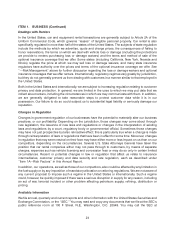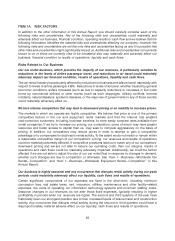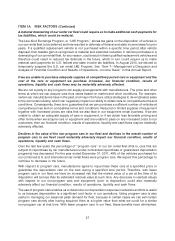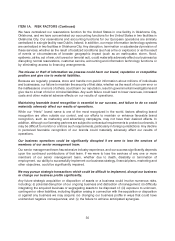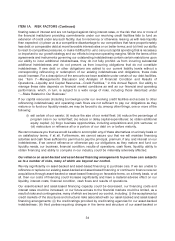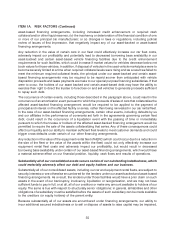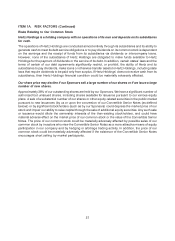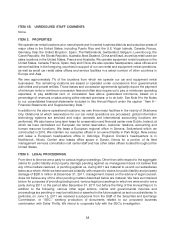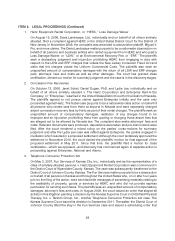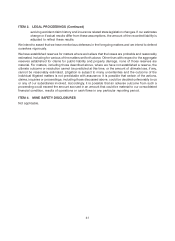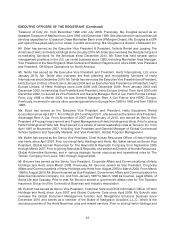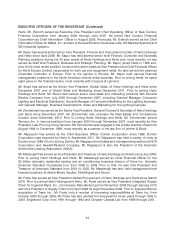Hertz 2011 Annual Report Download - page 60
Download and view the complete annual report
Please find page 60 of the 2011 Hertz annual report below. You can navigate through the pages in the report by either clicking on the pages listed below, or by using the keyword search tool below to find specific information within the annual report.ITEM 1A. RISK FACTORS (Continued)
floating rates of interest and are not hedged against rising interest rates, or the risk that one or more of
the financial institutions providing commitments under our revolving credit facilities fails to fund an
extension of credit under any such facility, due to insolvency or otherwise, leaving us with less liquidity
than expected; (v) place us at a competitive disadvantage to our competitors that have proportionately
less debt or comparable debt at more favorable interest rates or on better terms; and (vi) limit our ability
to react to competitive pressures, or make it difficult for us to carry out capital spending that is necessary
or important to our growth strategy and our efforts to improve operating margins. While the terms of the
agreements and instruments governing our outstanding indebtedness contain certain restrictions upon
our ability to incur additional indebtedness, they do not fully prohibit us from incurring substantial
additional indebtedness and do not prevent us from incurring obligations that do not constitute
indebtedness. If new debt or other obligations are added to our current liability levels without a
corresponding refinancing or redemption of our existing indebtedness and obligations, these risks
would increase. For a description of the amounts we have available under certain of our debt facilities,
see ‘‘Item 7—Management’s Discussion and Analysis of Financial Condition and Results of
Operations—Liquidity and Capital Resources—Credit Facilities,’’ in this Annual Report. Our ability to
manage these risks depends on financial market conditions as well as our financial and operating
performance, which, in turn, is subject to a wide range of risks, including those described under
‘‘—Risks Related to Our Business.’’
If our capital resources (including borrowings under our revolving credit facilities and access to other
refinancing indebtedness) and operating cash flows are not sufficient to pay our obligations as they
mature or to fund our liquidity needs, we may be forced to do, among other things, one or more of the
following:
(i) sell certain of our assets; (ii) reduce the size of our rental fleet; (iii) reduce the percentage of
program cars in our rental fleet; (iv) reduce or delay capital expenditures; (v) obtain additional
equity capital; (vi) forgo business opportunities, including acquisitions and joint ventures; or
(vii) restructure or refinance all or a portion of our debt on or before maturity.
We cannot assure you that we would be able to accomplish any of these alternatives on a timely basis or
on satisfactory terms, if at all. Furthermore, we cannot assure you that we will maintain financing
activities and cash flows sufficient to permit us to pay the principal, premium, if any, and interest on our
indebtedness. If we cannot refinance or otherwise pay our obligations as they mature and fund our
liquidity needs, our business, financial condition, results of operations, cash flows, liquidity, ability to
obtain financing and ability to compete in our industry could be materially adversely affected.
Our reliance on asset-backed and asset-based financing arrangements to purchase cars subjects
us to a number of risks, many of which are beyond our control.
We rely significantly on asset-backed and asset-based financing to purchase cars. If we are unable to
refinance or replace our existing asset-backed and asset-based financing or continue to finance new car
acquisitions through asset-backed or asset-based financing on favorable terms, on a timely basis, or at
all, then our costs of financing could increase significantly and have a material adverse effect on our
liquidity, interest costs, financial condition, cash flows and results of operations.
Our asset-backed and asset-based financing capacity could be decreased, our financing costs and
interest rates could be increased, or our future access to the financial markets could be limited, as a
result of risks and contingencies, many of which are beyond our control, including: (i) the acceptance by
credit markets of the structures and structural risks associated with our asset-backed and asset-based
financing arrangements; (ii) the credit ratings provided by credit rating agencies for our asset-backed
indebtedness; (iii) third parties requiring changes in the terms and structure of our asset-backed or
34


